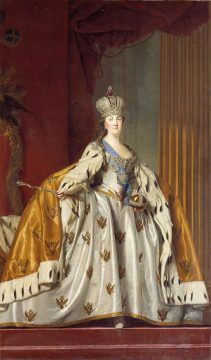Meilan Solly in Smithsonian:
 Catherine the Great is a monarch mired in misconception. Derided both in her day and in modern times as a hypocritical warmonger with an unnatural sexual appetite, Catherine was a woman of contradictions whose brazen exploits have long overshadowed the accomplishments that won her “the Great” moniker in the first place.
Catherine the Great is a monarch mired in misconception. Derided both in her day and in modern times as a hypocritical warmonger with an unnatural sexual appetite, Catherine was a woman of contradictions whose brazen exploits have long overshadowed the accomplishments that won her “the Great” moniker in the first place.
…To put it bluntly, Catherine was a usurper. Aided by her lover Grigory Orlov and his powerful family, she staged a coup just six months after her husband took the throne. The bloodless shift in power was so easily accomplished that Frederick the Great of Prussia later observed, “[Peter] allowed himself to be dethroned like a child being sent to bed.” Born Princess Sophie of Anhalt-Zerbst, a principality in modern-day central Germany, in 1729, the czarina-to-be hailed from an impoverished Prussian family whose bargaining power stemmed from its noble connections. Thanks to these ties, she soon found herself engaged to the heir to the Russian throne: Peter, nephew of the reigning empress, Elizabeth, and grandson of another renowned Romanov, Peter the Great. Upon arriving in St. Petersburg in 1744, Sophie converted to Eastern Orthodoxy, adopted a Russian name and began learning the to speak the language. The following year, the 16-year-old wed her betrothed, officially becoming Grand Duchess Catherine Alekseyevna.
Catherine and Peter were ill-matched, and their marriage was notoriously unhappy. As journalist Susan Jaques, author of The Empress of Art, explains, the couple “couldn’t have been more different in terms of their intellect [and] interests.”
More here.
